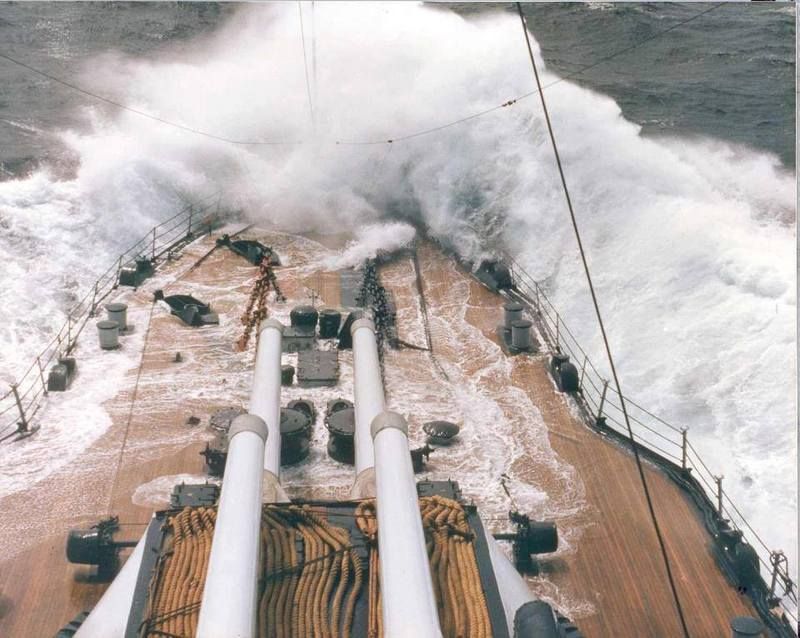
Cool photo…thank you for sharing
Love it!
The picture really shows how the deck stanchions and lines work. PE always leads to the impression that ships have big bar railings around their main decks, usually not so.
Water in the waterways, water everywhere.
Having walked those decks more than a time or two, they are a tad unique. The life line stanchions sit down in a gutter of sorts (if more of a rabbet). This surface is approximately the 2.25-2.5" thickness of the wood deck and the sleepers the deck is fastened to. The stanchions actually sit in sockets with a mix of bolts and pins holding them in place. Which juibes with contemporary photos showing the lifelines all cleared away when the main batteries are fired. Also, this makes the 36" long stanchions on Texas quite short vis-viz deck height–no reasonable person will spend much time leaning on them (a lubberly practice at best, anyway)–the brackish water of the Houston Ship CHannel not being very inviting even on a hot Texas summer day.
Interesting the dark color of the deck fittings compared to the light grey of the gun barrels.
And Capn----ain’t the smell worth it just to stand on those decks!!! And if you ever get the chance to get in the bowels of the ship-like in the engine room-that is the smell of history.
I wanted to wear a black belt in sea scouts, the scoutmaster convinced me not to.
Are the lines stored on the turret for paravanes?
Paravanes used wire. The lines on the turret appear to be fiber lines
More than likley mooring lines. They look like the mooring lines we used aboard ESSEX in 1960.
EJ
DOH!
You are of course correct!
Some of that contrast could just be the way the color film was processed; some could be from it being an overcast day. I’m guessing that Texas is in the pre-war light grey over dark grey paint scheme. Which also neatly explains the unstained decks, too. As to smells, yes, being aboard has many of them. Sadly, that decking only dates to the 1990 era dry docking–before that the decks had been stripped away and concrete put in their place (for some inexplicatble reason). The interior spaces have a number of smells. Some of those are old paint; some are legacies of the Houston Ship Channel ![]()
But, all ships tend to have a smell of paint, of electricity, of the sea–even hints of steam and diesel and bunker oil.
Here are a few original color photos taken on board USS Idaho around 1940 or so for comparison
Note how “blonde” Idaho’s decks are versus Texas’–even where they’ve wetted the deck down in the last photo. Note the russet linoleum on the signal platform in that last photo, too.
It’s late at night for me, and I just finally got around to ordering the Trumpeter Texas, so apologies, but were the decks stained for it’s WWII service (how it is on ‘museum’ display now) or would they have been like displayed in the op picture?
And, if so, why wouldn’t all ships have ‘camo’ deck stains? It would seem that many, at least in the modeling world, sported naked unstained decks natuaral wood decks.
Thanks!
Yes, USN painting instructions called for 20B deck stain for wooden decks, and a matching paint for metal decks. (Only thing we cannot answer is whether the russet linoleum applied to working metal deck surfaces remaind, or was painted (linoleum “takes” paint, so, I suspect it was).
I suspect Royal Navy painted or stained their wooden decks in wartime–I just cannot point to a refereence that says so (unlike USN practice).
I’ve seen the lumber used for Texas’ present wood deck, it has a distinct red hue; the stain the Texas Parks & Wildlife service uses replicates the USN color very well.
Is it anything like the mahogany stain on USS Enterprise here?
Can’r 'splain that one–othe than E was always in need, and in a hurry, and not with time to complete things like painting. But, the directives were to stain wooden decks,
I believe the Navy in the 1930s had a color designated"mahogany flight deck stain, which was reserved for carriers. I’m not sure when those carriers switched to the blue stain.
Snyder and Short are pretty definite that this occured prior to our entry into the war, July to October 1941 at the latest. And yes, the previous brown color was also a stain.
If only this was in colour! http://youtu.be/lJQ3nawnDRc